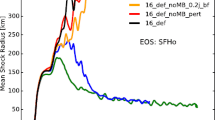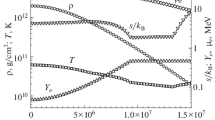Abstract
We compute the effect of collapse models on neutrino oscillations. The effect of the collapse is to modify the evolution of the spatial part of the wave function and we will show that this indirectly amounts to a change on the flavor components. For the analysis we use the mass proportional CSL model, and perform the calculation to second order perturbation theory. As we will show, the CSL effect is very small—mainly due to the very small mass of neutrinos—and practically undetectable.
Similar content being viewed by others
Notes
Equation (7) differs from those one typically finds in the literature only because the latter are written in the ultra-relativistic approximation \(E=\sqrt{\mathbf{p}^{2}c^{2}+m^{2}c^{4}}\simeq pc (1+\frac{m^{2}c^{4}}{2p^{2}c^{2}} )\).
In the following, we will consider decoherence effects only on electronic and muonic neutrinos.
A proof of this can be found in Sect. 2.3 of [47]. There, the proof is worked out for the Dirac equation coupled with an electromagnetic field. This is the same case as ours, if one sets A(x)=0 and \(eA_{0} (x )=-\hbar\sqrt{\gamma_{m}}w (x )\).
Here and in the following we use the notation of [47].
As well know in Quantum Field Theory, the reason why we used :N I (t): in place of N I (t) is that, with this prescription, we can remove all divergent contributions coming from tadpole diagrams. This type of divergences can be absorbed through a renormalization procedure, without giving any physically observable consequence [51, 52].
In general, spontaneous collapses and decoherence are described by similar master equations.
References
Bell, J.S.: Speakable and Unspeakable in Quantum Mechanics. Cambridge University Press, Cambridge (1986)
Adler, S.L., Bassi, A.: Science 325, 275 (2009)
Weinberg, S.: (2011) arXiv:1109.6462v3 [quant-ph]
Leggett, A.J.: J. Phys. A 40, 3141 (2007)
Arndt, M., Nairz, O., Vos-Andreae, J., Keller, C., van der Zouw, G., Zeilinger, A.: Nature 401, 680 (1999)
Hackermüller, L., Hornberger, K., Brezger, B., Zeilinger, A., Arndt, M.: Nature 427, 711 (2004)
Gerlich, S., Hackermller, L., Hornberger, K., Stibor, A., Ulbricht, H., Gring, M., Goldfarb, F., Savas, T., Müri, M., Mayor, M., Arndt, M.: Nat. Phys. 3, 711 (2007)
Gerlich, S., Eibenberger, S., Tomandl, M., Nimmrichter, S., Hornberger, K., Fagan, P.J., Tüxen, J., Mayor, M., Arndt, M.: Nat. Commun. 2, 263 (2011)
Marshall, W., Simon, C., Penrose, R., Bouwmeester, D.: Phys. Rev. Lett. 91, 130401 (2003)
Romero-Isart, O.: Phys. Rev. A 84, 052121 (2011)
Ghirardi, G.C., Grassi, R., Benatti, F.: Found. Phys. 25, 5 (1995)
Fu, Q.: Phys. Rev. A 56, 1806 (1997)
Ghirardi, G.C., Pearle, P., Rimini, A.: Phys. Rev. A 42, 78 (1990)
Ghirardi, G.C., Rimini, A., Weber, T.: Phys. Rev. D 34, 470 (1986)
Adler, S.L.: J. Phys. A 40, 2935 (2007)
Bassi, A., Ghirardi, G.C.: Phys. Rep. 379, 257 (2003)
Adler, S.L.: Quantum Theory as an Emergent Phenomenon. Cambridge University Press, Cambridge (2004)
Pearle, P.: Phys. Rev. D 13, 857 (1976)
Pearle, P.: Phys. Rev. A 39, 2277 (1989)
Pearle, P.: In: Breuer, H.-P., Petruccione, F. (eds.): Lecture Notes in Physics, vol. 526. Springer, Berlin (1999)
Diósi, L.: J. Phys. A, Math. Gen. 21, 2885 (1988)
Diósi, L.: Phys. Lett. A 129, 419 (1988)
Beuthe, M.: Phys. Rep. 375, 105 (2003)
Gonzalez-Garcia, M.C., Nir, Y.: Rev. Mod. Phys. 75, 345 (2003)
Giunti, C., Kim, C.W.: Fundamentals of Neutrino Physics and Astrophysics. Oxford University Press, Oxford (2007)
Gonzalez-Garcia, M.C., Maltoni, M.: Phys. Rep. 460, 1 (2008)
Christian, J.: Phys. Rev. Lett. 95, 160403 (2005)
Penrose, R.: Gen. Relativ. Gravit. 28, 581 (1996)
Penrose, R.: In: Fokas, A., et al. (eds.) Mathematical Physics 2000, Imperial College, London (2000)
Diósi, L.: Phys. Rev. A 40, 1165 (1989)
Ghirardi, G.C., Grassi, R., Rimini, A.: Phys. Rev. A 42, 1057 (1990)
Wolfenstein, L.: Phys. Rev. D 17, 2369 (1978)
Mikheyev, S.P., Smirnov, A.Yu.: Sov. J. Nucl. Phys. 42, 913 (1985)
Benatti, F., Floreanini, R.: Phys. Rev. D 71, 013003 (2005)
Lisi, E., Marrone, A., Montanino, D.: Phys. Rev. Lett. 85, 1166 (2000)
Fogli, G.L., Lisi, E., Marrone, A., Montanino, D.: Phys. Rev. D 67, 093006 (2003)
Aseev, V.N., Belesev, A.I., Berlev, A.I., Geraskin, E.V., Golubev, A.A., Likhovid, N.A., Lobashev, V.M., Nozik, A.A., Pantuev, V.S., Parfenov, V.I., Skasyrskaya, A.K., Tkachov, F.V., Zadorozhny, S.V.: Phys. Rev. D 84, 112003 (2011)
Nakamura, K., et al.: J. Phys. G, Nucl. Part. Phys. 37, 075021 (2010)
Diósi, L.: Braz. J. Phys. 35, 260 (2005)
Stodolsky, L.: Phys. Rev. D 36, 2273 (1987)
Marciano, W.J., Parsa, Z.: J. Phys. G 29, 2629 (2003)
Flowers, E.G., Sutherland, P.G.: Astrophys. J. 208, L19 (1976)
Fogli, G.L., et al.: Phys. Rev. D 76, 033006 (2007)
McKeown, R.D., Vogel, P.: Phys. Rep. 394, 315–356 (2004). And references therein
Adler, S.L., Bassi, A.: J. Phys. A 40, 15083 (2007)
Donadi, S., Bassi, A., Curceanu, C., Di Domenico, A., Hiesmayr, B.C.: Found. Phys. 43, 813 (2013)
Greiner, W.: Relativistic Quantum Mechanics—Wave Equations. Springer, Berlin (2000)
Sakurai, J.J., Tuan, S.F.: Modern Quantum Mechanics. Addison-Wesley, Reading (1994)
Tumulka, R.: J. Stat. Phys. 125, 821 (2006)
Bedingham, D.J.: Found. Phys. 41, 686 (2011)
Greiner, W.: Quantum Electrodynamics 3Ed. Springer, Berlin (2003)
Greiner, W., Reinhardt, J.: Field Quantization. Springer, Berlin (1996)
Bertlmann, R.A., Durstberger, K., Hiesmayr, B.C.: Phys. Rev. A 68, 012111 (2003)
Adler, S.L.: Phys. Rev. D 62, 117901 (2000)
Acknowledgements
The authors wish to thank S.L. Adler, M. Bahrami, A. Di Domenico and B. Hiesmayr for many useful and enjoyable conversations on this topic. They also acknowledge partial financial support from NANOQUESTFIT, INFN, the COST Action MP1006 “Fundamental problems in Quantum Physics” and the John Templeton Foundation project “Experimental and theoretical exploration of fundamental limits of quantum mechanics”.
Author information
Authors and Affiliations
Corresponding author
Appendices
Appendix A: Dimensional Estimate of the Decay Rate
Here we wish to discuss about the possibility of estimate the predictions of the CSL model in neutrino oscillations by using dimensional analysis. Collapse models, as discussed in Sect. 4, are described by the same type of master equations as open quantum systems (which experience decoherence due to interactions with an external environment). In such a case it is well known that the effect of decoherence is to suppress exponentially flavour oscillations. So it does not come as a surprise that for collapse models the effect is the same. Then one could try to guess the decay rate with dimensional analysis, using the relevant constants and parameters of the model. First of all is reasonable to suppose that the effect is proportional to the strength of the noise γ. Moreover, since we are using the mass proportional CSL model, for which γ is replaced by \(\gamma_{m_{j}}\equiv\gamma (\frac{m_{j}}{m_{0}} )^{2}\), one expects also a factor \(m_{0}^{2}\) in the denominator. Because [γ]=cm3s−1, and the decay rate must have dimension s−1, we need to introduce terms with dimension cm−3. Since the parameter r C has the dimension of a length, then it is natural to introduce an \(r_{C}^{3}\) in the denominator. Finally, we need to introduce terms with the dimension of a squared mass. The simplest choices are:
Both these formulas are different compared to the correct one given by Eq. (8). If we substitute the values of the constants and the parameters and we consider, for example, the case of the cosmological neutrinos, we get:
The formula derived with dimensional analysis shows that the CSL effect on neutrino oscillations is very small, practically undetectable. However, it differs by many orders of magnitude from the exact (perturbative) result. We performed the lengthy calculation present here in order to arrive at a fully trustable result. As we have seen here above, dimensional analysis does not allow to reach a firm conclusion.
Appendix B: Approximation in the Calculation of \(I_{j}^{ (2 )}\)
In this appendix we justify the approximation we used in order to derive Eq. (62) from Eq. (61). This amounts to proving that:
To see this, we can rewrite the integral in polar coordinates and integrate over the angular variables:
Let us introduce the dimensionless variable \(s=\frac{ (p-p_{i} )r_{C}}{\hbar}\):
If p i c≫ħc/r C ∼10 eV (the typical range of momenta of neutrinos is between 103 eV and 1019 eV) we can disregard s both in the numerator and denominator, obtaining:
which is the desired result.
Appendix C: Approximation in the Calculation of \(I_{jk}^{ (1 )}\)
Here we justify the approximation we used to pass from Eq. (58) to Eq. (59). We start with Eq. (58):
where:
The first part of the integrand:
is a composition of polynomial functions of \({\bf p}_{f}\), and we can safely assume that it does not change too much, within the range where the Gaussian function is appreciably different from zero. Therefore we can then take \({\bf p}_{f} = {\bf p}_{i}\); by using also the relation:
Eq. (78) becomes:
Now we have to focus our attention on the integral I, which contains an oscillating term that needs special care. As before, we write the integral in polar coordinates and perform the integration over the angular variables; moreover, we introduce once again the a-dimensional variable \(s=\frac{ (p_{f}-p_{i} )r_{C}}{\hbar}\). We have:
where we have defined:
with
Our goal is to show that g(s) does not vary appreciably, within the range where the Gaussian term is significantly different from zero, and can be approximated with g(0)=0; in this way, the integral can be computed exactly. This kind of approximation is not obvious because the factor ct/r C in front of Eq. (84) can be very big.
In the ultra-relativistic limit, we approximate the particle’s velocity with the speed of light. In this limit, y 2≫a j ,a k , and so we can expand the square roots in g(s) using the Taylor series \(\sqrt{x+\epsilon}=\sqrt{x}+\frac{\epsilon}{2\sqrt{x}}\) and we get:
In order for g(s) to remain small within the interval where the Gaussian term of Eq. (83) is appreciably different from zero, we need:
In all physically interesting situations, the term on the right hand side of Eq. (87) is bigger than 1; moreover s is of the order of unity, because of the Gaussian in Eq. (83). Inequality (87) is verified if the following condition is true:
Typically, cosmogenic neutrinos have energies bigger than 1018 eV and travel distances of at most 109 light-years [27]. This means that, in the worst case, ct/r C ∼1032 while (a j −a k )=(10−2 eV−2) \((m_{j}^{2}c^{4}-m_{k}^{2}c^{4})\simeq(10^{-2}~\text{eV}^{-2})(2\times10^{-3}~\text{eV}^{2})=10^{-5}\). So we must have y≫1014, that means p i c=y/(10−1 eV−1)≫1015 eV, which is satisfied.
For atmospheric neutrinos, ct/r C is in the range 1011−1014 while the range of energies is between 10−1 GeV and 104 GeV [25]. This means that, even in the worse case, the condition to check is y≫105, which means p i c=y/(10−1 eV−1)≫106 eV. This is also satisfied.
Rights and permissions
About this article
Cite this article
Donadi, S., Bassi, A., Ferialdi, L. et al. The Effect of Spontaneous Collapses on Neutrino Oscillations. Found Phys 43, 1066–1089 (2013). https://doi.org/10.1007/s10701-013-9732-6
Received:
Accepted:
Published:
Issue Date:
DOI: https://doi.org/10.1007/s10701-013-9732-6




